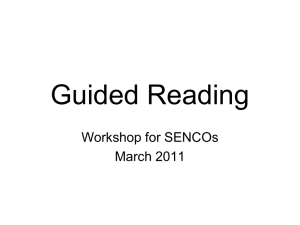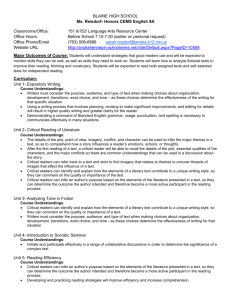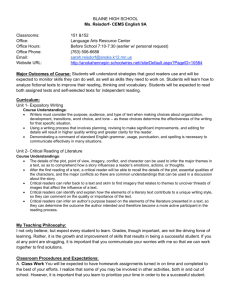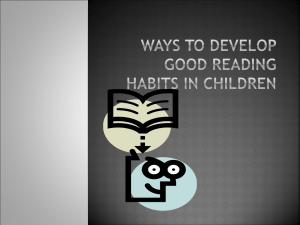he values of such courses within teacher education
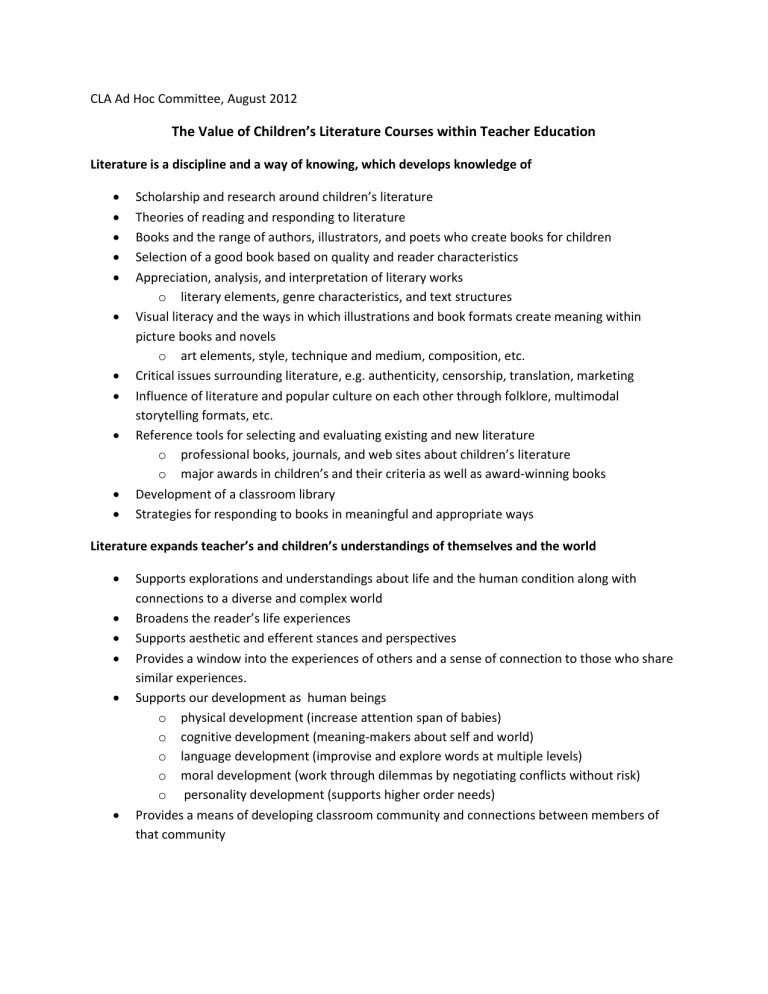
CLA Ad Hoc Committee, August 2012
The Value of Children’s Literature Courses within Teacher Education
Literature is a discipline and a way of knowing, which develops knowledge of
Scholarship and research around children’s literature
Theories of reading and responding to literature
Books and the range of authors, illustrators, and poets who create books for children
Selection of a good book based on quality and reader characteristics
Appreciation, analysis, and interpretation of literary works o literary elements, genre characteristics, and text structures
Visual literacy and the ways in which illustrations and book formats create meaning within picture books and novels o art elements, style, technique and medium, composition, etc.
Critical issues surrounding literature, e.g. authenticity, censorship, translation, marketing
Influence of literature and popular culture on each other through folklore, multimodal storytelling formats, etc.
Reference tools for selecting and evaluating existing and new literature o professional books, journals, and web sites about children’s literature o major awards in children’s and their criteria as well as award-winning books
Development of a classroom library
Strategies for responding to books in meaningful and appropriate ways
Literature expands teacher’s and children’s understandings of themselves and the world
Supports explorations and understandings about life and the human condition along with
connections to a diverse and complex world
Broadens the reader’s life experiences
Supports aesthetic and efferent stances and perspectives
Provides a window into the experiences of others and a sense of connection to those who share similar experiences.
Supports our development as human beings o physical development (increase attention span of babies) o cognitive development (meaning-makers about self and world) o language development (improvise and explore words at multiple levels) o moral development (work through dilemmas by negotiating conflicts without risk) o personality development (supports higher order needs)
Provides a means of developing classroom community and connections between members of that community
Literature supports the development of multicultural perspectives for teachers and children
Immerses readers into the lives of characters from a wide range of cultural experiences, both multicultural and global
Helps readers develop an understanding of the world and of themselves
Promotes critical thinking through literature that raises difficult social and cultural issues
Develops awareness of the ways in which books and society often under-represent and stereotype culturally diverse groups
Provides the white dominant majority within teacher education with a sense of the cultural experiences of the diverse students in their classrooms o Teachers need more than information about diverse cultural groups and a sense of the experiences and perspectives of members of these groups.
Encourages teachers to value, understand and encourage the diverse personal and cultural connections and reflections of their students
Literature encourages teachers as readers
Develops personal enthusiasm for children’s literature and reading so teachers can invite their own students to be readers
Experiences the ways in which literary discussion and social interaction can help readers broaden their frames of reference for reflecting on and interpreting reading experiences and life perspectives through their own transactions with literature
Provides teachers with the experience of reading within a community of readers
Creates a commitment to classroom and school libraries
Engages teachers in analyzing ideas from multiple perspectives, building the habit of engaging in materials to making meaning from them, reaching thoughtful conclusions supported by compelling evidence, analyzing ideas from multiple perspectives, and writing to analyze.
Teachers need to engage in this thinking in order to develop these abilities in students.
Facilitates teachers’ understandings of childhood by immersing them in the diverse lives of children
Literature provides resources for teaching and learning across content areas and curriculum standards
Builds a broad knowledge of literature to consider for use in classrooms and with children, including digital and interactive texts
Provides knowledge necessary for selecting specific books to meet classroom needs in a time of declining budgets and increasing availability of high quality literature
Creates an understanding that literature has a wide range of uses that cut across all of the content areas
Builds background knowledge to support content area curriculum
Provides many resources to explain and teach concepts
Provides access to students because books are written at their level of understanding
Builds knowledge of informational books and their increasingly important role in classrooms
Builds knowledge of how to identify engaging texts and teaching strategies that prepare students for tests, support common core standards and satisfy curriculum requirements
Gains knowledge that is foundational to other methods courses, providing the material essential to lesson planning, strategy instruction, thematic design
Literature provides the tools that support children’s development as readers and writers
Develops the understanding that we need to teach children to want to read, not just teach them to read. Little attention is given to motivation in published reading materials. o Provides the choice that is essential to motivation. o Provides high quality and engaging books that children fall in love with o Supports struggling readers who need to find books that relate to their interests
Provides a source of high quality writing by authors who use a greater variety of engaging words that supports vocabulary development
Develops ability to apply a wide range of strategies to comprehend, interpret, evaluate and appreciate texts. Supports a greater range of comprehension strategies, including inference.
Provides the materials for independent reading so that students can develop as readers by immersing themselves in books that appeal to them. The more children read, the better readers they become.
Develops knowledge of how help readers choose books that suit their interests and abilities.
Supports the development of an attitude of life-long reading for personal purposes
Develops the evaluative criteria and knowledge needed to assess pre-packaged reading curricula and book sets
Builds the knowledge of books necessary for teaching writing in specific genres and identification of mentor texts and author craft
Provides demonstrations of diverse forms of writing




